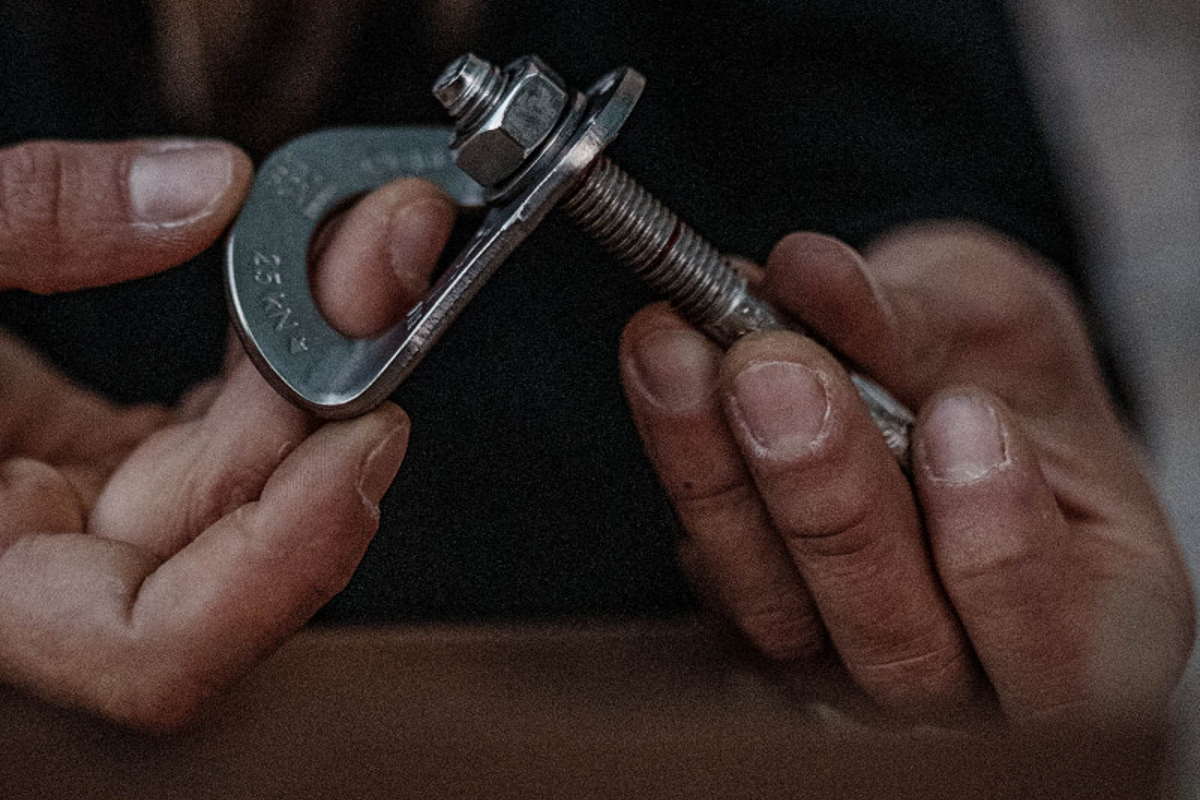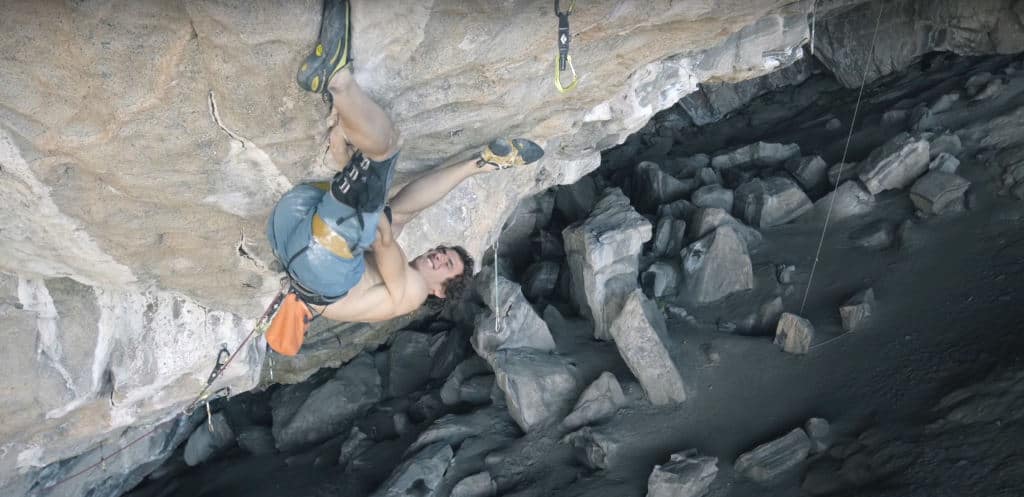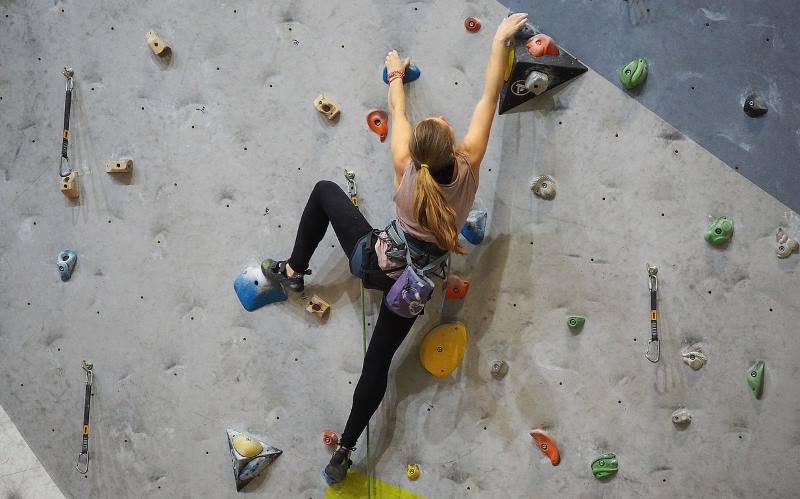Ever jumped on a nice easy route for a warm up, only to find yourself pumped and searching a blank wall for anything that looks remotely like a hold? You may have just been sandbagged.
What Does Sandbag Mean In Climbing?
A sandbag is a route which is under-graded, normally by a fair bit. Meaning the route is much harder than graded. You often find out a route is a sandbag when you struggle to get mid-way on a grade you’d normally flash or you hear maniacal laughter from your belayer below.
Sandbagging a route means to give it a lower grade than it probably deserves. Sometimes this means a that the original climber who graded it though it was easier than most people would. Sometimes it comes from a time when climbing grades were much different.
Sandbagging can also apply to when people climb a hard route and give a personal opinion that the grade should be lower. It can be an ego thing but at the same time can depend on individual’s strengths, beta, and condition.
The term isn’t to be confused with actually using a sandbag while belaying – commonly used in gyms when you have a heavier climber. Although the idea of carrying a sandbag while climbing can be akin to the added difficulty of a sandbagged climb.
What Does Sandbagging Someone Mean?
To sandbag someone means to tell them a route is actually easier than it is. “Oh yeah that route’s super fun, you’ll do it easy”. You can sandbag any type of route – boulders, sports, trad, big walls, ice.
Whether this is a fun prank or a dick move is up for debate.
Where Did The Term Sandbag Come From?
Sandbagging is a popular term used in many sports or games to describe a similar thing. Basically if someone is sandbagging, they are pretending to be worse than they actually are.
From the merriam-webster dictionary: –
In the 19th century, the verb sandbag began to be used to describe the act of bludgeoning someone with a small, sand-filled bag – a tactic employed by ruffians, usually as a prelude to robbing their victims. The verb went on to develop metaphorical extensions, such as “to coerce by crude means.”
Pulling out a sandbag in Poker is a common term for “slow playing” a hand. You pretend the cards you’ve got aren’t good in order to keep people betting to raise the pot. Then you pull out the sandbag hand and clobber everyone for the win.
Why Do Routes Get Sandbagged?
1 – Grades Are Subjective
Routes normally get graded by the first person to climb them. Sometimes the person that climbed the route found that to be the appropriate grade for them. Routes can be very height dependent and everyone has their own strengths and weaknesses.
Specific techniques also factor in to a lot of grading. Some people have great endurance and excellent footwork while others might have insane finger strength and can lock-off on a dime.
In many desert areas of the USA crack climbs are everywhere. If you grew up on crack climbing then the technique is pretty straight forward. If you’ve literally never jammed before it’s a whole new world.
Check out world class Japanese boulderers getting shut down on M4 at the Meiringen IFSC World Cup below while Ondra cruises it. The problem starts at 1:30:40 and you can see Ondra giving a bit of advice early on at 16:40.
If you flash a problem because you knew the beta, saw the right chalk marks, were in peak physical condition, and managed to find the holds perfectly – does it mean the route was easy or that you just had a good day?
2 – Old School Grading
To this day grades are hotly debated. There are multiple different systems used around the world and arguments about for which is the most accurate.
Honing in on the US where the Yosemite Decimal System is used, the first free climbing grades of 5.8 and 5.9 were considered almost impossible. Not everyone climbed in the same areas so weren’t able to compare routes – only judge based on written testimony.
As a result you’d find very strong climbers reading about these feats and not believing that they could be climbing at that level. There was a strong culture of being humble in your achievements and to over-grade something could lead to ridicule.
As a result there are a huge amount of 5.8 and 5.9 graded climbs that vary wildly in their actual technical difficulty. Some of the first ascentionists might hazard a + on top of the main grade to indicate it was a little harder.
It wasn’t until many traveled and found the variety of route differences that grading started to get up to 5.10. 5.9 especially is where sandbagging is rife and the grade you should most look out for. Any “classic” 5.9 or 5.9+ is worth assuming as a being a grade or two harder.
More Climbing Jargon Explained
What Is A Runout In Climbing?
What Does Climbing Onsight Mean?
What Is Climbing Beta?
What Does Redpoint Mean?
3 – Grading Is More Accurate / Modern Grades Are Soft / Grade Inflation
As climbing became more popular, routes got repeated, and people started traveling between areas – it was clear that consensus was helpful. Initially climbs in the US were just given a grade of 1 to 5 for steepness, 1 being a walk, 5 being a technical climb.
Yosemite Decimal System
The Yosemite Decimal System subdivided the 5 grade into 5.0 through 5.9. It was first used by climbers of the Sierra Club in Tahquitz (not Yosemite) Royal Robbins, Don Wilson, and Chuck Wilts and spread from there. 5.9 was initially means to be the hardest climb possible but now grades reach up to 5.15d.
As climbers saw big differences between two grades – for example 5.10’s – they started to assign letters from a through to d. So a 5.10a is easier than a 5.10b, then 5.11c is harder than that, 5.10d harder again – then jumping to 5.11a and so on. Sometimes a plus might be given to indicate a route was a little harder.
Sport Climbing – French Grades
The same thing happened with sport climbing and the French grading system. Here the grading numbers don’t correspond to the YDS. Originally a simple number like 4, 5, 6 was given. As grades increased and people saw the different between a hard or easy 6, letters started to be used like 6a, 6b, 6c.
Then within that the + grade was used, so now we have 6a, 6a+, 6b e.t.c. It’s worth noting that the YDS system also takes into account the difficulty of protecting the climb and it’s “seriousness” whereas the French Sport system is just about technical climbing difficulty.
Note – There are way more grading systems than this and we haven’t even touched on bouldering.
As a result modern route grading tends to be more accurate. Some route climbers don’t grade until they have input from others to get a consensus – which can be helpful. It’s still subjective and routes can change over time from rockfall, holds breaking, and erosion.
However, changing grading on classic routes isn’t taken to very well. Guidebooks and website often publish the original grade but also give the modern rough grading, or just say the route is a “classic” as a nod on what to expect.
4 – Different Areas – Different Ethics
Following on from classic grading – many people believe routes should be graded according to other routes in the area. So if there are a good few classic 5.9’s and your new route isn’t any harder than those (even though everyone that’s climbed it would call it 5.10c) it should be graded as 5.9. What is a sandbag is very subjective.
Some areas are renowned as having “stiff” grading and can be a big of a shock to the ego. At the same time “holiday” grading is a thing, where lots of modern sports areas in Europe seem over-graded and easy in comparison to a home crag.
5 – It’s Funny(?)
Quite a few people would say it’s not and please don’t take this as a suggestion to sandbag someone into a scary situation. But – it is sort of funny to see a confident, strong climber getting nearly totally shut down on a something they would consider a basic day out climb.
If you’ve climbed for long outside you’ve probably been sandbagged by either a friend or a guidebook. We’ve definitely been flummoxed by that “easy for the grade” route and the old classic: “it’s totally your style, you’ll flash it”.
Maybe on the route it’s not the most fun – but learning to deal with tough situations and pulling through is a part of climbing. Plus it makes a great story and qualifies perfectly for type 2 fun.
How To Tell If A Route Is A Sandbag?
- If a US graded route has a + on it, it’s probably an old route that’s way harder by modern standards. The plus is the most anyone will go to changing a classic grading
- It says “easy” or “easy for the grade” in the guidebook…
- Your friend suggests an easy route but won’t let you see the guidebook
What Is The Opposite Of A Sandbag?
If a sandbag is under-grading a route, then the opposite would be to over-grade a route and make it seem harder than it actually is. There isn’t really a word for it apart from a route being “soft”.
Some people would argue lots of modern routes are overgraded or given soft grading. There aren’t that many examples of routes that are the opposite of a sand-bag but it does happen. We all know the soft 7a that everyone claims as their first of the grade.
There are plenty of instances where climbers have proposed a grade and then another climber has downgraded it – the James Pearson story was a big one in the world of UK trad. The problem is that it’s very hard to grade a route if you are the only person that’s done it. Grading nowadays tends to work out over the first few ascents with input from a few people.
Are Gyms Routes Over-Graded?
The way that gyms grade is generally very soft compared to outside. Gym route grading just doesn’t correspond to outside routes. We’re not complaining or bragging here and actually think this is a good thing. It just tends to be a shock for climbers going outside for the first time.
With gyms it feels better to see clear delineation between difficulties so its clearer what to choose for practice. It’s easier to choose the right routes and get in more mileage. Outdoors one grade might contain a wide variety of hard or soft routes within a 5.12a for example.
Gym setting is an endless debate and to be honest the best way of doing things would be to establish a new grading system. However, no-one wants a new grading system so the best idea is also a terrible one. For now we think grading routes within a color and having variance within that is the best solution.
Classic Sandbag Areas
Any classic climbing areas with free climbs established any time before the 70’s are probably rife with sandbags.
There are plenty of multi-pitch 5.4 to 5.9’s that are fairly easy in lots of sections but have moves that individually might be well over the grade given. These also tend to have sketchy runouts, pegs, home-made bolts, or other old-school surprises.
Tahquitz is where the Yosemite Decimal system was first used. It has plenty of routes that are harder than their grade implies – but at the same this is where the grade were defined, so are they really sandbagged?
Yosemite has a lot of classics like the Steck-Salathé, and Bachar-Yerian that would be very differently graded these days. The same goes for many of the boulders in the valley. The Shawnagunks (the gunks) is another classic area with lots of hard low grades.



